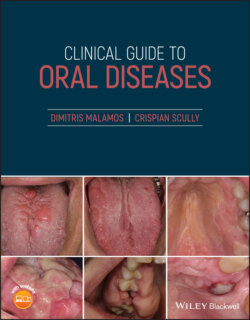Читать книгу Clinical Guide to Oral Diseases - Crispian Scully - Страница 26
Case 2.1
ОглавлениеFigure 2.1
CO: A 65‐year‐old woman was referred by her dentist for evaluation of a black discoloration of her buccal mucosae and palate.
HPC: The discoloration was firstly noticed by her dentist during a routine examination for denture replacement one week ago.
PMH: She was a slim woman with dark skin and with no serious medical problems apart from low blood pressure and chronic allergic asthma which were controlled with a special salty diet and systematic steroids respectively. She also suffered from iron deficiency anemia at child bearing age, and had been on iron tablets only on the days of menstruation. Smoking had been stopped from the age of forty.
OE: The intra‐oral examination revealed dark black–bluish discolorations on her buccal mucosae, soft palate and lips (Figure 2.1). This discoloration was diffuse, superficial, and prominent at areas of chronic friction such as at the occlusal line. Similar discolorations were seen on the skin of hands and feet. Fatigue, nausea, or even episodes of fainting during very tiring activities were occasionally reported.
Q1 Which is the possible diagnosis?
1 Racial pigmentation
2 Hemosiderosis
3 Addison's disease
4 Melasma
5 Melanoma
Answers:
1 No
2 No
3 Addison's disease is the cause of the dark pigmentation of her skin and oral mucosa (especially on buccal mucosae) which was attributed to the increased stimulatory action of adrenocorticotropic hormone (ACTH) in the melanocytes, changing the color of melanin pigment to black or dark. This disease is characterized with adrenal insufficiency (secondary) due to the chronic use of steroids for the patient's asthma, and with stimulation and overproduction of pituitary hormones like ACTH. Low blood pressure, weight loss, muscle and joint pain, nausea, diarrhea and fainting during exercise and increased pigmentation are among the commonest manifestations of this disease.
Comments: Dark pigmented lesions are common and distinguished in diffuse and discrete ‐localized lesions. Diffuse pigmentation is common in dark skin patients (see racial pigmentation).in pregnancy (melasma) or in diseases per ce (Addison) or induced by drugs (hemosiderosis) Localized lesions are common and some of them like melanoma jeopardize patient’s life Their diagnosis is based on clinical characteristics like onset, location, type of discoloration location and progress. Racial pigmentation is usually noticed at an earlier age and not associated with general symptomatology. Hemosiderosis causes a similar discoloration but is not the cause as the patient did not have a history of blood dyscracias or overtaking of iron tablets, and her pigmentation remained unchanged. Melasma is also found in pregnant women, but restricted mainly on facial skin while melanoma is associated with satellite pigmented lesions and has a more aggressive clinical course.
Q2 Addison's disease is characterized by:
1 Excess secretion of cortisol
2 Increased secretion of ACTH
3 Reduced secretion of aldosterone and cortisol
4 Reduced production of thyroid‐stimulating hormone (TSH)
5 Increased secretion of prolactin
Answers:
1 No
2 No
3 Reduced secretions of aldosterone and cortisol hormones are characteristic findings in Addison's disease, and caused either by disorders of the adrenal glands (primary) or inadequate secretion of ACTH from the pituitary gland (secondary).
4 No
5 Hyperprolactinemia is found in active phases of various autoimmune diseases such as systemic lupus erythematosus (SLE), rheumatoid arthritis, celiac disease, diabetes type 1 as well as Addison's disease.
Comments: An increased TSH, with or without low levels of thyroxine, occurs in patients with primary or secondary Addison's disease while increased cortisol and reduced ACTH levels are found in Cushing syndrome.
Q3 Addison's disease is commonly part of syndromes such as:
1 Crouzon syndrome
2 McCune‐Albright syndrome
3 Griscelli syndrome
4 Peutz‐Jeghers syndrome
5 Autoimmune polyendocrine syndrome
Answers:
1 No
2 No
3 No
4 No
5 Autoimmune polyendocrine syndrome (PAS II) is characterized by a drop in production of several essential hormones, commonly found in patients with Addison's disease; hypo or hyperthyroidism, hypogonadism, and diabetes mellitus type I.
Comments: Skin or oral mucosa discolorations are characteristically seen in various syndromes apart from Addison's disease. Skin hyperpigmentation is also seen in Cushing syndrome and in other syndromes combined with acanthosis nigricans and early craniosynostosis (Crouzon syndrome) and with polyostotic fibrous dysplasia, café au lait skin pigmentations (McCune Albright syndrome). Skin hypopigmentation together with silver gray hair discoloration alone, or combined with brain or autoimmune dysfunctions are characteristics of Griscelli syndrome.
